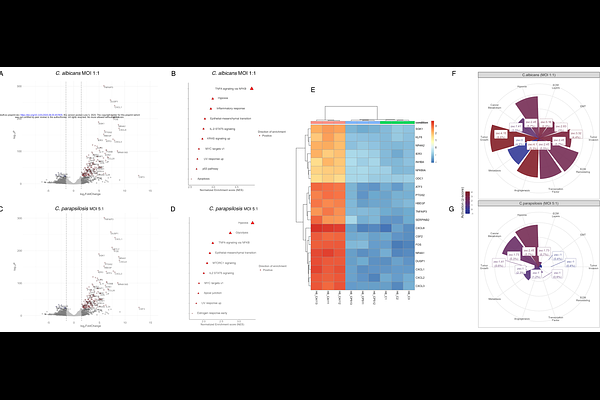Early Candida - Oral Tumor Interactions Suggest miRNA-Mediated Regulation of Inflammatory and Tumor-associated processes

Early Candida - Oral Tumor Interactions Suggest miRNA-Mediated Regulation of Inflammatory and Tumor-associated processes
Toth, R.; Horvath, M.; Naglik, J. R.; Gacser, A.
AbstractWhen simultaneously present, oral cancer and oral candidiasis are associated with high mortality. Recently, fungi-driven OSCC has emerged as a recognized phenomenon, that is triggered by Candida and sustained by several pro-tumor mechanisms. This study aimed to deepen our understanding and investigate how these mechanisms are regulated at the early stages of fungi-tumor interactions. Post-transcriptional regulation was examined through the analysis of miRNA (miR) responses in a metastatic cell line. We characterized early tumor responses to two common oral yeasts, C. albicans, frequently responsible for oral infections, and C. parapsilosis, a yeast with mostly commensal behavior in this niche. Exposed to C. albicans, tumor cells exhibited overexpression of inflammatory and pro-tumor pathways. This was also mirrored at the miR level. Intriguingly, this species induced upregulation of oncogenic miRs, while simultaneously downregulated tumor-suppressive miRs. miR-target analyses revealed targets primarily to be involved in inflammation (TNFa signaling via NFKB), albeit tumor progression was also heavily influenced based on the targets identified within the PanCancer Progression Panel. Several miR-target pairs were identified with TRIB1-miR-30c-1-3p highlighted at the route of inflammation, and MMP3-miR-374a-3p and JUN-miR-1268b/miR-16-1-3p/miR-30c-1-3p at the route of OSCC progression. These findings highlight that C. albicans drives OSCC progression, in part, through miR regulation. Contrarily, C. parapsilosis elicited tumor responses predominantly related to hypoxia and metabolic regulation, followed by a mild activation of inflammatory and tumorigenic processes. No significant miR-regulatory responses were identified. To sum up, we added a new layer to fungi-tumor interactions and identified regulatory elements, that might hold future translational potential.